ABCSell AR-18 USB Power Adapter Tear-Down: Another Death Trap
Transient Response
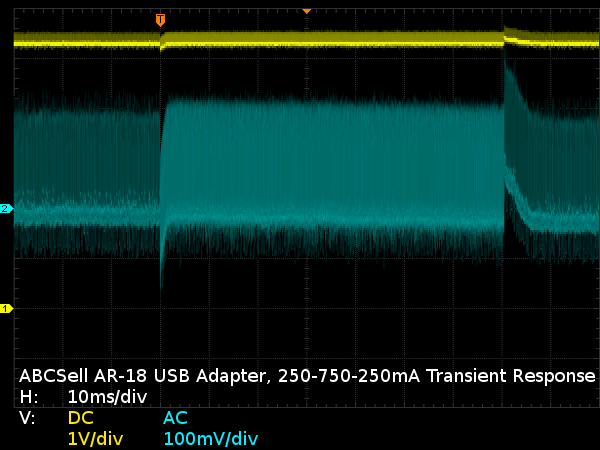
Upon transient application, the output voltage dips by approximately 100mV and the regulator needs a respectable two milliseconds to compensate. But when the transient gets removed, output shoots up by 150mV or so and needs at least five milliseconds to settle back down. That's about right for switching regulators with primary-side sensing that iteratively adjust based on the previous cycle’s feedback (as opposed to opto-isolators, which provide continuous proportional feedback).
Short-Circuit Response
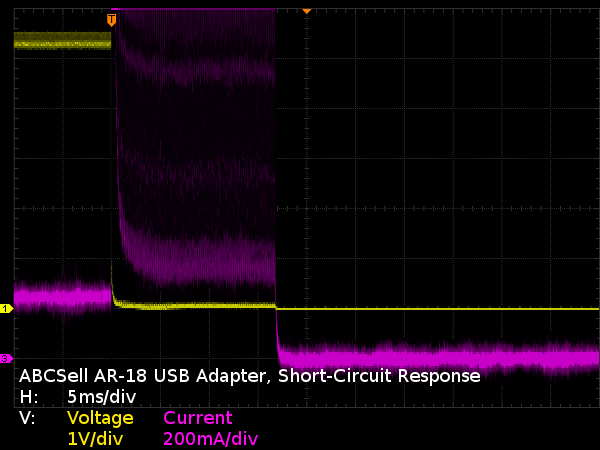
What happens under an output short-circuit condition? Exactly what you'd expect: the flyback converter tries to drive the output as hard as it can, and once it detects that the voltage isn’t coming back up, it shuts down for a little while. Here, the controller needs approximately 17ms to call it quits, taking a one-second break between restart attempts.
Isolation Withstand Test, Part One
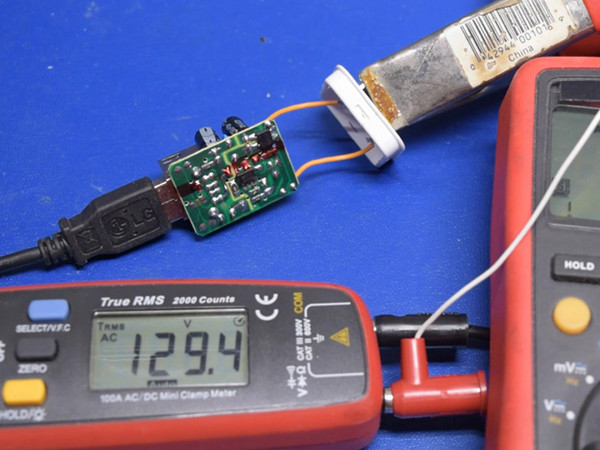
Based on past experience, a clean board with smooth copper traces can withstand as much as 2kV down to 0.5mm of creepage distance, which is more than what 1kV ceramic capacitors tend to fail at. Here, the minimum creepage is closer to double that amount, and the lack of solder mask makes it easy to tell the board is clean along its border. Since the transformers we've looked at so far have all made it past 2kV, the non-Y capacitor should be the weakest link.
Predictably enough, that’s exactly what happened at 1300V.
Dead Cap
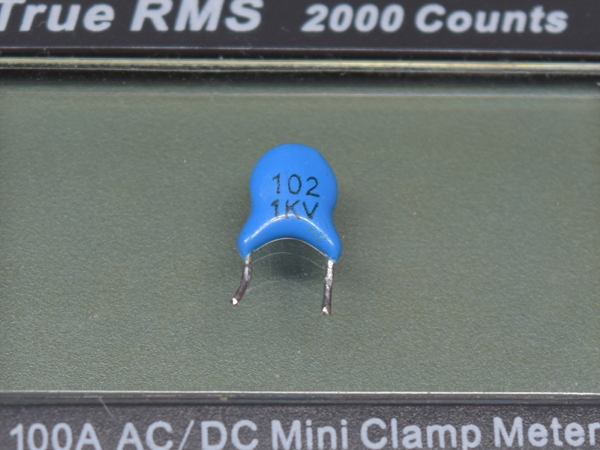
As is often the case with ceramic capacitors that have failed from a limited energy over-voltage, there is no way to tell when one is bad without actually testing them for withstand voltage. It typically takes tens of volts before the internal faults becomes conductive.
I let this capacitor stew for several seconds at 10mA (~3W), and it still shows no sign of overheating. If I really wanted to blow one of these up, I would need to crank both voltage and current up a notch by borrowing an old microwave oven’s transformer.
Isolation Withstand Test, Part Two
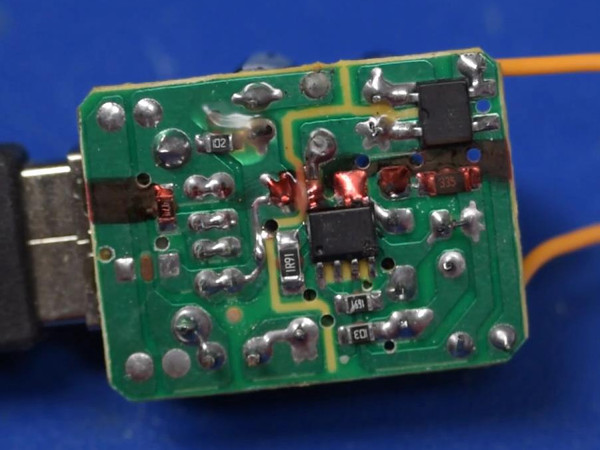
Again, as predicted, the second thing to fail is creepage across the board's primary and secondary boundary, from the corner of an SMD resistor pad on the primary side to a solder blob on the secondary side.
Stay On the Cutting Edge: Get the Tom's Hardware Newsletter
Get Tom's Hardware's best news and in-depth reviews, straight to your inbox.
Track Close-Up
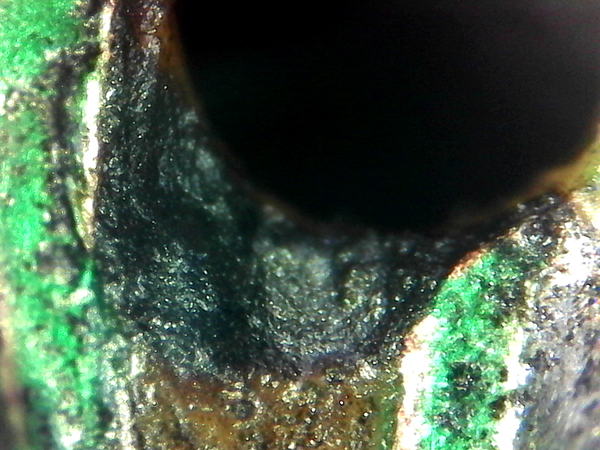
While the arc may have started between the slight copper point near the mid-right and the solder blob tip on the left, most of the charring is concentrated along the hole’s edge.
Since the edge of a hole has less specific heat to help it cope with thermal dissipation, the arc burnt itself a path across the separation and managed to creep most of the way across the hole from where it started. As old material smoldered and sputtered off, it enabled new and more effective paths to get charred into existence.
Transformer Close-Up
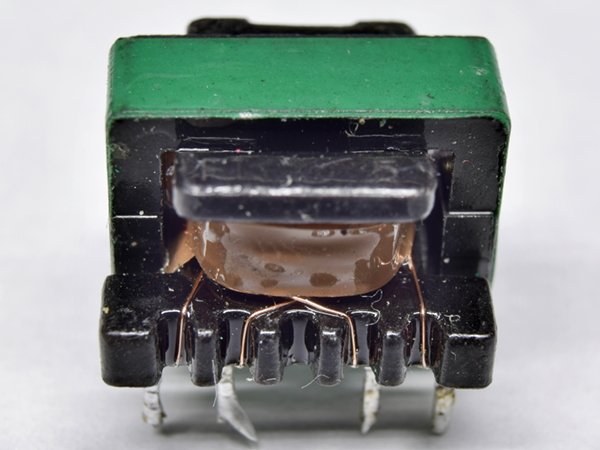
There is only one thing left to test to destruction: the transformer, which is also the most critical safety component. How far short of 3500VAC will it fail? What sorts of ugly secrets (aside from the lack of double-insulation) lie within?
I was really hoping for an arc fault between those two crossed wires. Is it wrong to be disappointed when something fails to fail?
Isolation Withstand Test, Part Three
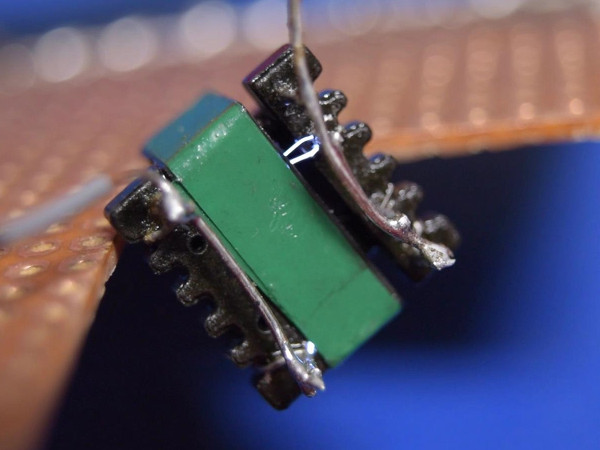
At first, it arced from pins and jumper wires to the ferrite core at around 2800V. That would have been okay if the board had a proper spark gap to prevent such a voltage difference from building up between sides. Then it went quiet. So now we now have an internal arc to investigate. What sort of horror are we going to dig out of it?
Transformer Autopsy
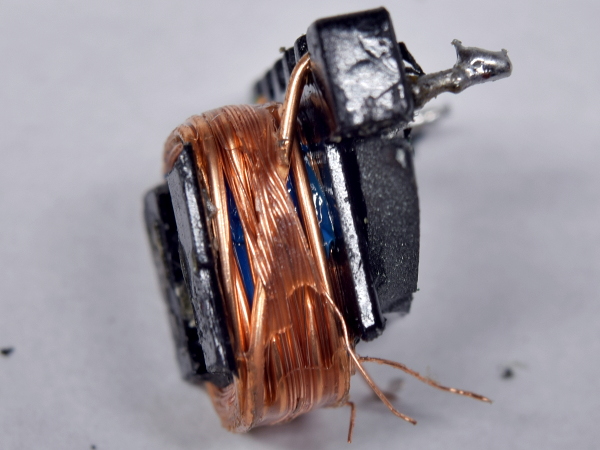
As far as transformer windings go, this is one of the worst possible cases imaginable, aside from an outright short between primary and secondary straight from the factory. Right under the top tape layer, the thin wire feedback winding sits directly on top of the much heavier-gauge output winding with nothing more than the wires’ coating separating them. All of the favorable conditions for a primary-to-secondary short are here.
I would not have expected the transformer to make it to 2800V like this.
Full-Contact Weave
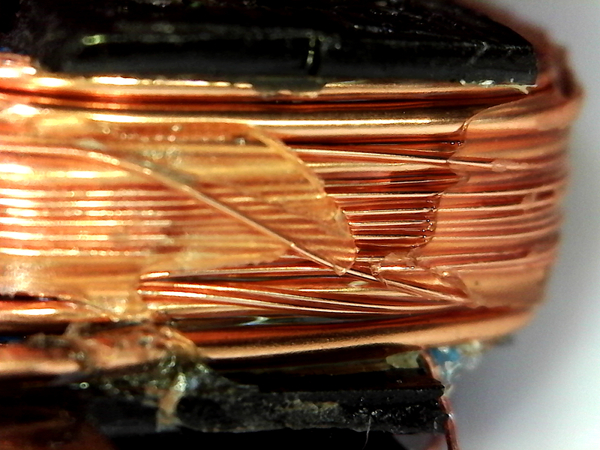
On the winding side opposite the previous image, the wiring is partially covered in a hard varnish or lacquer, and the feedback winding can be seen going over and between output winding turns.
While lacquering or varnishing windings can be used as an alternative to tape, this only works when windings are wound, fully varnished, and cured before the next winding is wound on top of it, not as a patchy job after everything has already been wound on the core.
-
dudmont Sauvageau, you've got a touch Doc Brown in you, don't you? "Now where am I going to find that 1.21 gigawatts?....."Reply -
chaz_music For me, the picture of the housing bottom side (plug view) is all that is needed. It does not have a UL or ETL mark on it. These are safety agency marks that certify that the device won't kill you. :)Reply
For Europe, you would also have a CE mark. I have found many power supply products in the past few years without UL or ETL on them. I won't use them if those marks are not there. That is because I am an engineer who has to make products that meet UL/ETL and CE. The requirements to meet these agency tests check for exactly the same thing that you showed in your tear down. And you did a great job!
Anything that connects to the utility or mains should have safety marks for your country.
- Charles -
wuethrichtech idk, i understand things in this world almost well enough to do tear downs like this...which is why i find myself torn. All the saftey features we would require if it were made here are left out and millions of these must be all around the world... where are the deaths? where are the fires that were not caught in time?Reply
yet having a decent understanding, If this sorta crap not only snuck by but was tolarted and produced here...id be extra woried about living in an apt where joe schmo the window licker is going to put one of these in every room and thinks he can rebuild his ebike battery with a pile of 18650s10w soldering iron and no bms -
Daniel Sauvageau Reply
If the adapter is the only thing nearby, it'll burn out, leave a scorched wall outlet and dry-wall, probably go unreported. If there are tons of things nearby and many of them are possible causes, then the fire will burn all of them beyond recognition and the exact cause may be left undetermined.20927821 said:All the saftey features we would require if it were made here are left out and millions of these must be all around the world... where are the deaths? where are the fires that were not caught in time?
For deaths by electrocution to occur, the user needs to provide a relatively low impedance to ground, which usually isn't the case when people are on dry ground and their phone is the only thing they are touching. Even a shock from 240Vac while wet and grounded isn't a guaranteed death, it'll definitely be painful well beyond anything that could be considered acceptable exposure. If you look for non-lethal shock reports, those are plentiful. Any of those could turn lethal under more unfortunate circumstances.
When all it takes to make things significantly safer is a tiny bit more care in the board layout, sufficiently wide insulation tape between transformer layers and some sleeving at least on the secondary, there really is no excuse for these death-trap grade adapters to exist. These things are accidents waiting to happen, only a matter of when and what the circumstances will be when they do. -
jdog2pt0 Could spend your whole life tearing apart this cheap crap, and if you like electronics tear downs (especially unsafe ones) check out Bigclive on youtube. Otherwise, my rule of thumb when buying chargers and the like is to....buy Anker and be done with it.Reply -
gasaraki Why don't you tear apart a name brand non-apple charger for once? Like an Anker Quick-charger or something. Or show us a name brand Samsung or LG charger. Tearing apart no name chargers are well and good but no one is going to buy those crap.Reply -
Daniel Sauvageau Reply
I've had at least three of those: SilverStone UC01, Aukey PA-U32, Philips SPS8038, four if you count the PrimeCabkes/iKits charging station / device organizer which is also miles ahead of generic adapters.20930057 said:Why don't you tear apart a name brand non-apple charger for once?
As for "nobody would buy those", I'm pretty much certain millions of these dangerous adapters are bought by unwary people every year, hence the importance of promoting awareness of how unsafe they can be. Both of my sisters have a couple "dollar store specials" which I'm planning to trade them for as I find adapters that meet my grade.
At the moment, Aukey's PA-U32 is at the top of my list, as does another device from a new name in this category, albeit after modding to fix what looks like an unfortunate design flaw in what otherwise appears to be a top-notch adapter. You'll see that last one in late-May.
As for seeing more Aukey or some Anker, Roger got me a pair of each. The first one's tear-down will likely be out in June. I meant to start working on it while dog-sitting at my sister's home but forgot to bring my other adapters, so that's on hold until the next time I drop by my apartment later this week. -
tproveau I have a two usb out 2.4A each outlet 4.8A total power adapter made by Ubiolabs that is a very big seller since it retails at Costco in the US. It is UL listed I.T.E. power supply, FCC and RoHS compliant. Model # is CHG1003 B/N 110116HJT. Input 100-240 volt~50/60Hz 0.7A. My question is it looks to be a safe unit considering the label but is it? The package comes with two five foot long USB to micro USB cables and sells for eight bucks. Why buy the unknown stuff from China when you can get this package locally so inexpensive? Also being so inexpensive is it up to what it appears to be?Reply
Thanks